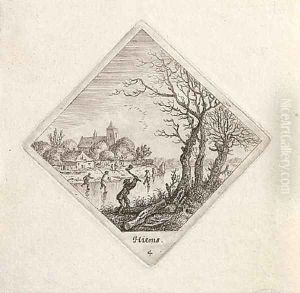Hermann Saftleven II Paintings
Hermann Saftleven II was a Dutch Golden Age painter and etcher born on January 2, 1609, in Rotterdam, Netherlands. He hailed from a family deeply entrenched in the arts; his father, Herman Saftleven I, was a painter, as was his brother, Cornelis Saftleven. Herman II's early life was spent in Rotterdam, where he likely received his initial artistic training from his father before continuing his education in the vibrant artistic circles of the Dutch Republic.
Saftleven's oeuvre is diverse, encompassing landscapes, genre scenes, and occasional portraiture, but he is best remembered for his detailed landscape paintings. These works often depicted the Rhine Valley, where he moved later in life, particularly around Utrecht, where he settled permanently around 1632. His landscapes are notable for their meticulous attention to detail, balanced compositions, and the serene, harmonious portrayal of nature. Saftleven's ability to capture the essence of the Dutch and German countryside with a delicate, refined touch became a hallmark of his work, influencing subsequent generations of landscape artists.
Beyond his landscape work, Saftleven was also known for his genre scenes that depicted everyday life with a keen eye for detail and a gentle sense of humor. His etchings and drawings further attest to his versatility and skill as an artist, showcasing his ability to work across different media with ease.
Throughout his career, Saftleven enjoyed considerable success and was highly regarded by his contemporaries. He was a member of the Utrecht Guild of Saint Luke, where he held various positions, including headman, which underscores his influence and standing within the artistic community of his time. Despite the challenges of the period, marked by economic fluctuations and the impact of the Thirty Years' War on the Dutch Republic, Saftleven's work continued to be sought after by patrons and collectors.
Hermann Saftleven II passed away on October 5, 1685, in Utrecht. His legacy lies not only in his contributions to the Dutch landscape genre but also in his influence on the development of naturalistic landscape painting in Europe. Today, his works are held in high esteem and can be found in prestigious museums and collections worldwide, continuing to enchant viewers with their beauty and serene depiction of the natural world.
